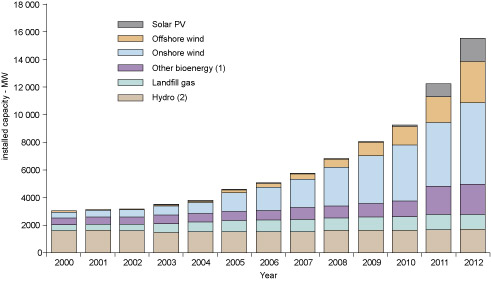5.13 Large-scale implementation
PV module fabrication is essentially the same for all cell types, and is a very different sort of process from cell manufacture. It therefore lends itself to the establishment of independent module fabrication facilities that are able to handle a number of different initial cell materials. This enables local fabrication using local labour that is not dependent on high technology nor particularly sensitive to the cell materials. The same PV modules may be built from different components. The performance of the final assembly in different complete installations is a crucial engineering test.
As the number of installations increases, the prices of systems come down and domestic embedded generation becomes more and more viable. When the amount of electricity generated by PV installations reaches about 10% of the total amount of electrical energy available from the national grid, the grid will no longer act as an effective store. This is because the seasonal nature of the energy supply will be too erratic for the grid demand. Electricity generation by all renewables in the UK in 2011 was about 9.4%, with PV contributing a small, but growing fraction (Figure 101).
Activity 45 (self-assessment)
A medium-to-long-term problem for PV, and for renewables in general, is the question of energy storage. What's needed is the energy equivalent of a portfolio of investment accounts covering short-, medium- and long-terms.
Suggest two ways that energy from PV can be stored. Think in broad terms about the answer, and consider all the different forms of 'energy' and energy storage that you've encountered in the course. Comment in each case on the storage time scale and any environmental issues.
Answer
You may have chosen two of the following:
- a.Hydro-storage is one possibility, but in the UK for instance, there are very few environmentally acceptable sites available. Long-term storage is, in principle, possible this way.
- b.A short-term, small-scale solution is battery storage. A medium-term energy bank is available when electricity and water are mixed; that's something that I was always taught to avoid doing! The electrolysis of water to produce hydrogen and oxygen is a straightforward process. This is converting solar energy, through electrical energy, to 'chemical energy', if you like. The hydrogen can be stored for later use; burning it recombines it with oxygen to make water and heat energy. However, hydrogen gas itself is not easy to contain and this is a bulky way to store energy. Various techniques are being developed such as pressurisation, liquefaction, adsorption on adsorbent surfaces and conversion to other fuels such as ammonia, methane or methanol.
- c.Other options might be to store energy as electric current in a ring of superconducting material or as kinetic energy by spinning a large fly-wheel.
Don't forget that the discussion here concentrates on electricity production, but the majority of energy use is as heat. You'll need to follow modules on renewable energy to see the whole picture.

